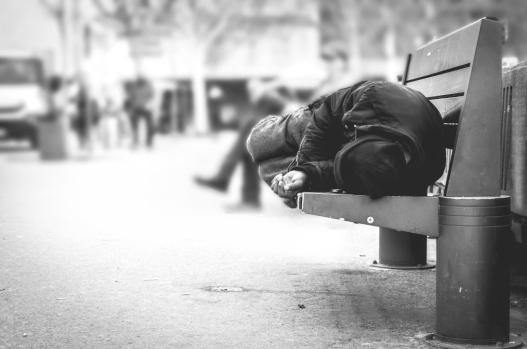This story first appeared in Melbourne University’s Pursuit
By Eoin Hahessy, University of Melbourne
“I sit here from 7.30 in the morning to 8 at night and make sometimes between 7 to 8 dollars. Other times, other homeless people who know I can’t chase them steal my money.’’The words of Graham, 42, who suffers from cerebral palsy and has been living on the streets of Melbourne for 18 months.
Melbourne, voted the world’s most liveable city for six consecutive years, has seen an extraordinary rise in homelessness recently with a 74 per cent increase in the street count in the last two years.
Melbourne is a confident and wealthy city. Niche coffee houses clamber for attention in a city where the choice of weekend brunch destination is fervently discussed. Yet the lingering shadow of homelessness creeps further upon its streets. Take a walk along Swanston Street, the main artery that dissects Melbourne, and the increase in the homeless is glaringly evident.
Cheryl, 26, has been homeless for more than a year, on and off. Her hands tremble as we speak; her boyfriend was physically abusive that morning. “We had a huge row and he hit me,’’ she says, clutching a cigarette that gives relief from both the cold and the anguish she is in.
Statistics are flung at us, arrows seeking our attention. But when you pause and reflect on Melbourne and Australia’s homeless challenge, those statistics illustrate an issue that receives scant public debate.
At least 105,000 people are homeless in Australia. Around 44 per cent are women, often in circumstances involving domestic violence. There are nearly 18,000 children without homes, most under the age of 12. Indigenous Australians, who comprise around 2.5 per cent of the general population, make up a quarter of the homeless population.
Every developed nation in the world grapples with the challenge of homelessness, but in recent years the homeless problem in Melbourne has become acute.
WHAT IS DRIVING THE HOMELESS RATE IN MELBOURNE?
“There is some great research that shows having a healthy supply of affordable housing has a protective effect. Those people more vulnerable to homelessness are less likely to become homeless when there is affordable housing,’’ says Deb Batterham, a researcher at Launch Housing, an organisation that under various labels has been working with the homeless in Melbourne for more than 75 years.
“Metropolitan Melbourne continues to register very low levels of rental affordability,’’ the Victorian State Government’s most recently quarterly rental report states dryly. As Melbourne’s appetite for designer homes and luxury apartments grows larger, the ground that affordable housing should occupy becomes simply ‘prized real estate’.
An ever-smaller pool of affordable housing is one of the reasons behind this complex challenge. Other experts concur and also point to the rising cost of living for those on unemployment benefits. “About 57 per cent of low-income households in metropolitan Melbourne are paying over 30 per cent of their income on rent, with almost a third paying over 50 per cent on rent,’’ says Professor of Urban Planning at the University of Melbourne, Carolyn Whitzman. “That is a choice between paying your rent and feeding yourself.’’
LACK OF HOUSING
But what about Australia and the wider homeless rate across this boundless continent? Professor Whitzman points again to the lack of affordable housing. “Across Australia there is a shortage of 122,000 affordable houses. Australia has experienced a real stop-start attitude to national urban policy. When you have got 25 per cent of households that simply cannot afford housing in the major cities, where the jobs and services are, then you have a dysfunctional housing system.”
Professor Whitzman sees the problem of homelessness lying in this wider Australian policy towards the housing market.
“There’s been a rapid decline in affordable housing rental stock from 1996 to 2011 and again, it’s not as though there isn’t money there; there has been a rapidly increasing amount of money put by the Commonwealth Government into negative gearing and capital gains and as a recent report by the Grattan Institute has shown, the majority of that $11 billion that goes per annum out of capital gains tax and negative gearing, goes to the richest 10 per cent of the population.”
WHAT CAN MELBOURNE AND AUSTRALIA LEARN FROM OTHER COUNTRIES?
It is 1.30am on a Melbourne morning and on the phone from New York is Sam Tsemberis. All he wants to talk about is the homeless people that The Policy Shoppodcast spoke to.
“What age is he? He has cerebral palsy and is still on the streets? Tell me more about Helen.” It’s genuine compassion from a Columbia University psychologist and founder of an organisation that has flipped conventional thinking towards the chronic, or most vulnerable, homeless in the United States.
At one point at the turn of the millennium New York was spending US$40,500 a year on every homeless person with mental illness. As the Washington Post reported, that’s when Sam Tsemberis came in.
Homelessness services had traditionally worked like a reward system: lose the addiction, get a home. Tsemberis and his organisation, Housing First, challenged this conventional thinking. Instead of setting criteria for homeless people to obtain a home, Housing First simply gives homeless people a roof over their heads, no questions asked.
It was a simple but radical idea for policy makers looking to solve a homelessness problem in America that had steadily risen since the 1970s. One such policy maker was Philip Mangano, who became President George Bush’s ‘Homelessness Czar’ in 2002. Mangano initially thought the notion of Housing First could never work, but he studied the program and in particular a cost benefit analysis.
Traditionally, homeless people are bounced around health systems, from counselling services to A&E to drug and alcohol addiction programs. It’s a ricochet that was costing the US healthcare system an average of US$150,000 per homeless person per year, whereas the Housing First approach of giving someone a home cost US$25,000. Initially a skeptic, Mangano became an ardent devotee.
With this backing by the Executive Director of the United States Interagency council on Homelessness, more than 100 cities across the US would adopt Tsemberis’s Housing First model. The ambitious target was to end chronic homelessness in ten years. Five years in and a 40 per cent decrease in homelessness has been indicated.
“In some of the larger studies, there was a 50 per cent reduction in the cost of inpatient services alone and a 30 per cent drop in outpatient services because remember, this is a lot about housing, but some of the people we’re housing will need clinical support. So it’s housing and services,” says Tsemberis on The Policy Shop podcast.
“Housing First is a little bit misnamed. It’s housing first but it’s not housing only – it’s housing and support services.’’
In achieving success under this Housing First model in the United States, a partnership approach between all levels of government proved essential. “In some of the places that have gotten to zero, effectively it’s taken five, six, seven, eight years. It has been a partnership not only within local providers but between municipality and Country Government and Federal Government.”
Ultimately Tsemberis feels that the challenge of homelessness needs political will if change is to occur, and that that political conviction will only happen when public attitudes towards those who are homeless change.
“We have learned to look away, to avert our eyes, not only from the person on the street but from the entire issue. It’s a rather small, non‑voting group and so it’s up to advocates to make the case but sadly, that’s what’s happened.
“The public attitude is what drives policy. For every single label that they attribute, it’s a distancing from them and us and that creates the possibility then of not having to deal with that other human being. Thinking of the poor as different than us, thinking of the poor as somehow less than us, has a long, long tradition in history.”
Eoin Hahessy is the Producer of The Policy Shop podcast which examined homelessness in its most recent episode. The Policy Shop is available on iTunes, SoundCloud, Omny and Stitcher.
Comment below to have your say on this story.
If you have a news story or tip-off, get in touch at editorial@governmentnews.com.au.
Sign up to the Government News newsletter
Most read
Scathing report finds little has changed at PwC
Qld council welcomes progress on massive battery system
Inquiry to consider how federal govt can address councils’ sustainability issues
‘Local’ procurement turns out not to be so local, committee hears
Another report finds local government falling down on cyber security


